Disclosure: This article contains affiliate links. We may earn a commission from purchases at no extra cost to you, which helps our travel content.
There's something magical about the way Cape Town's golden light cascades over Table Mountain at dusk, creating a photographer's paradise unlike anywhere else I've experienced. Having visited the Mother City numerous times over the past decade—most recently to participate in the Cape Town Marathon and scout locations for a potential eco-luxury property—I've developed an intimate relationship with this South African gem's most photogenic corners. Cape Town offers that rare blend of dramatic natural landscapes, vibrant urban culture, and poignant historical sites that create a visual storyteller's dream canvas. Whether you're wielding the latest mirrorless marvel or simply your smartphone, these 12 locations will not only elevate your Instagram feed but also connect you to the soul of this magnificent destination in ways that transcend the digital realm.
Table Mountain: The Icon from Every Angle
No visual journey through Cape Town would be complete without capturing the city's magnificent centerpiece from multiple perspectives. While the classic postcard shot from Bloubergstrand Beach offers that quintessential view of Table Mountain framed by the Atlantic, I've discovered that the mountain reveals different personalities throughout the day and from various vantage points.
My personal favorite moment came during last year's visit when I hiked Lion's Head at dawn. Starting the ascent at 4:30 AM with my headlamp lighting the path, I reached the summit just as the first golden rays illuminated Table Mountain's facade. The interplay of light and shadow across the mountain's flat top created texture and dimension that simply doesn't exist later in the day.
For those seeking a less strenuous option, the view from Signal Hill offers an accessible yet equally dramatic composition, especially at sunset when the city lights begin to twinkle below. During the blue hour—that magical time just after sunset—the mountain becomes a silhouette against an indigo canvas, creating a moody contrast that performs beautifully on camera.
The Cableway station itself presents another perspective entirely. Rather than shooting outward from the mountain, turn your lens toward fellow visitors silhouetted against the vast landscape beyond. Human elements add scale and emotional resonance to these grand vistas, transforming a scenic shot into a storytelling moment.
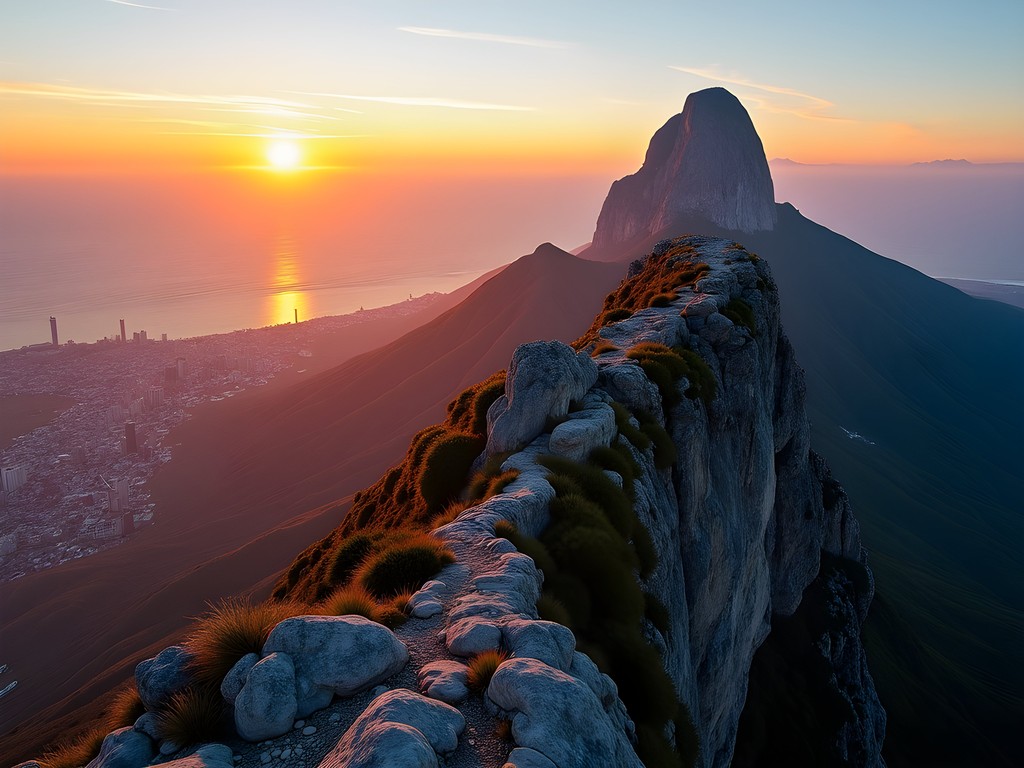
💡 Pro Tips
- Visit Table Mountain on clear days for optimal visibility—check the 'tablecloth' cloud coverage before heading out
- The golden hour (one hour after sunrise or before sunset) creates dramatic shadows across the mountain's face
- Include human elements for scale and emotional connection in your wide landscape shots
Bo-Kaap: A Kaleidoscope of Color
The moment you turn onto Wale Street and encounter the rainbow-hued houses of Bo-Kaap, you understand why this historic neighborhood has become one of Cape Town's most photographed areas. What many visitors miss, however, is the rich cultural context behind this visual feast—this is the historic home of Cape Town's Cape Malay community, with a heritage dating back to the 17th century.
Rather than simply capturing the colorful facades, I've found that the most compelling images emerge when you engage with the neighborhood more deeply. During my last visit, I participated in a cooking class with a local family, learning to make traditional Cape Malay curry while hearing stories of the area's complex history. The resulting photographs of spice-stained hands preparing food against the backdrop of those vibrant walls carried far more meaning than architecture alone.
The light here is particularly magnificent in the late afternoon, when the setting sun intensifies the already vivid colors. To avoid the crowds that gather mid-day, I recommend arriving either at early morning (around 8 AM) or during the golden hour before sunset. This not only provides better light but allows for more authentic interactions with residents going about their daily lives.
Composition-wise, look for contrasting color combinations between adjacent houses, or frame architectural details against the dramatic backdrop of Table Mountain. The cobblestone streets themselves tell a story—try low-angle shots that incorporate these textural elements into your foreground.
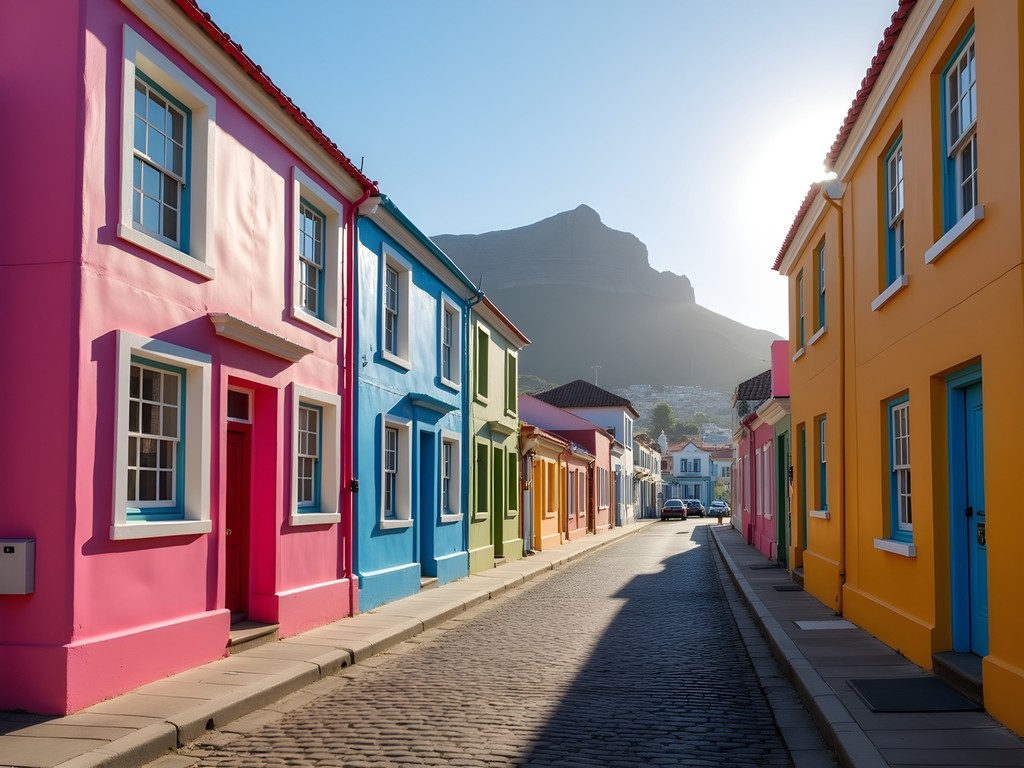
💡 Pro Tips
- Visit early morning or late afternoon to avoid tour groups and harsh midday light
- Ask permission before photographing residents—a smile and respectful approach usually receives a warm welcome
- Look for cultural details beyond the colorful houses—spice shops, mosques, and daily life scenes tell the deeper story
Cape Point & Cape of Good Hope: Where Oceans Meet
There's something profoundly moving about standing at what feels like the edge of a continent, where the Atlantic and Indian Oceans create a dramatic confluence of currents. Cape Point and the Cape of Good Hope offer some of the most spectacular coastal photography opportunities I've encountered in my travels—dramatic, windswept landscapes that evoke a sense of wilderness despite being just an hour's drive from Cape Town.
The iconic Cape Point Lighthouse perched dramatically above the churning ocean makes for classic compositions, but I encourage you to explore beyond this familiar scene. The hiking trails along the rugged cliffs offer countless vantage points where you can capture the wild beauty of this peninsula. During my visit training for the Cape Town Marathon, I discovered secluded lookouts that provided unique perspectives of the coastline without another soul in sight.
Weather here changes rapidly, creating dynamic lighting conditions that can transform your images from moment to moment. I always pack my weather-resistant camera bag when visiting this area, as sudden mist or rain showers can roll in unexpectedly, creating both challenges and opportunities for atmospheric photography.
Wildlife adds another dimension to your Cape Point portfolio. The resident baboon troops provide entertaining subjects (though keep a respectful distance), while ostriches sometimes strut across the landscape, creating surreal juxtapositions against the dramatic scenery. If you're fortunate, you might spot dolphins or southern right whales from the higher vantage points during migration season (June to November).
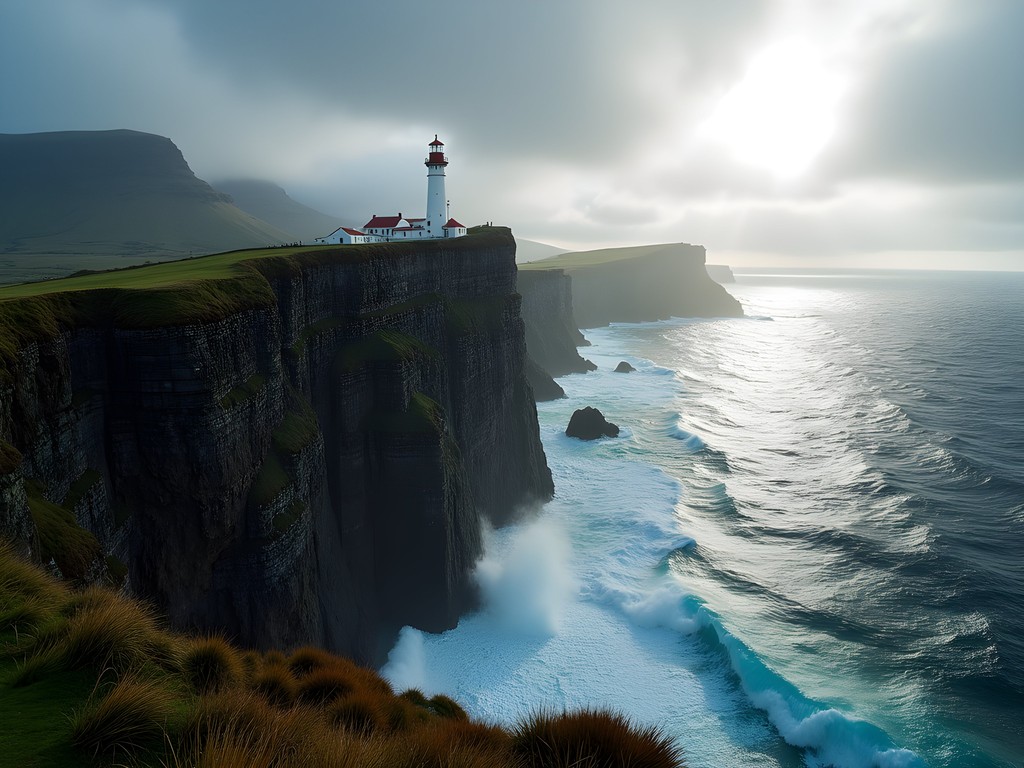
💡 Pro Tips
- Visit on weekdays to avoid weekend crowds, and arrive early (the park opens at 6 AM in summer)
- Bring a telephoto lens for wildlife and a wide-angle for the expansive coastal landscapes
- Use graduated neutral density filters to balance bright skies with darker foregrounds in your coastal shots
Kirstenbosch Botanical Gardens: Nature's Perfect Frame
Nestled against the eastern slopes of Table Mountain, Kirstenbosch isn't just one of the world's most beautiful botanical gardens—it's a masterclass in natural composition. As someone who incorporates biophilic design elements into hotel spaces, I find endless inspiration in how the garden's creators have framed Table Mountain through strategic plantings and pathways.
The Tree Canopy Walkway (affectionately known as the 'Boomslang') offers my favorite photographic opportunity in the gardens. This curved steel and timber bridge rises through the trees, creating leading lines that draw the eye toward the mountain beyond. Visit in the morning when the light filters through the canopy, creating dappled patterns that add depth and dimension to your images.
During spring (September to November), the garden explodes with the colors of native fynbos and proteas—South Africa's national flower. For macro photography enthusiasts, these endemic species offer extraordinary subjects with their unusual geometric forms and vibrant hues. My macro lens rarely leaves my camera when I visit during this season.
The sculptures scattered throughout the garden create compelling juxtapositions of art and nature. The large dinosaur sculptures in the Cycad Amphitheatre are particular favorites, especially when photographed against the mountain backdrop—ancient forms echoed in the ancient landscape.
Don't rush your visit; the changing light throughout the day transforms the gardens continuously. I typically spend a full morning here, finding that the quality of light between 8-11 AM offers the perfect balance for botanical photography—soft enough to avoid harsh shadows yet directional enough to reveal texture and form in the plantings.
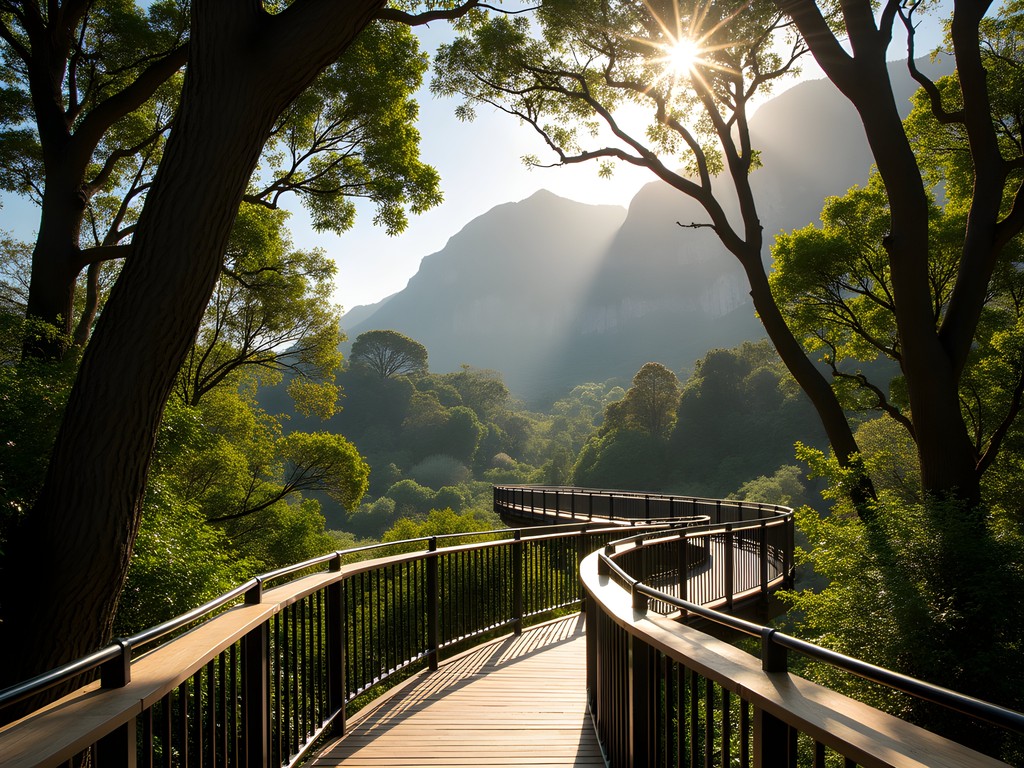
💡 Pro Tips
- Visit on weekdays to avoid weekend crowds, particularly during protea blooming season
- Bring a polarizing filter to reduce glare on leaves and enhance the saturation of the garden's colors
- Use the garden's natural frames—archways, tree canopies, and stone pathways—to create depth in your compositions
V&A Waterfront: Harbor Life Meets Urban Luxury
While some photographers dismiss the V&A Waterfront as overly commercial, I've found this vibrant harbor precinct offers a fascinating visual study in contrasts—working fishing boats alongside luxury yachts, historic architecture juxtaposed with contemporary design, all against the omnipresent backdrop of Table Mountain.
The golden hour transforms this area completely. As the setting sun bathes the harbor in warm light, the water becomes a mirror reflecting the mountain and maritime activity. Position yourself near the swing bridge for compositions that incorporate both the harbor's nautical elements and the mountain beyond. The Clock Tower, painted a distinctive red, provides a striking focal point against the blue harbor waters.
The Cape Wheel offers elevated perspectives of the waterfront that reveal patterns and geometries not visible from ground level. While the wheel itself makes for an interesting subject when photographed at night with long exposures, riding it provides unique aerial vantage points of the harbor layout below.
The Zeitz Museum of Contemporary Art Africa (MOCAA) deserves special attention from architectural photographers. This repurposed grain silo complex features a fascinating honeycomb interior that plays with light and shadow throughout the day. The contrast between the building's industrial exterior and the sculptural interior spaces creates compelling visual narratives about transformation and repurposing.
Food photographers will find endless subjects in the V&A Food Market, where local vendors create visually stunning dishes that tell the story of Cape Town's diverse culinary heritage. As someone who appreciates both plant-based cuisine and visual composition, I find this market offers the perfect intersection of gastronomy and photography.
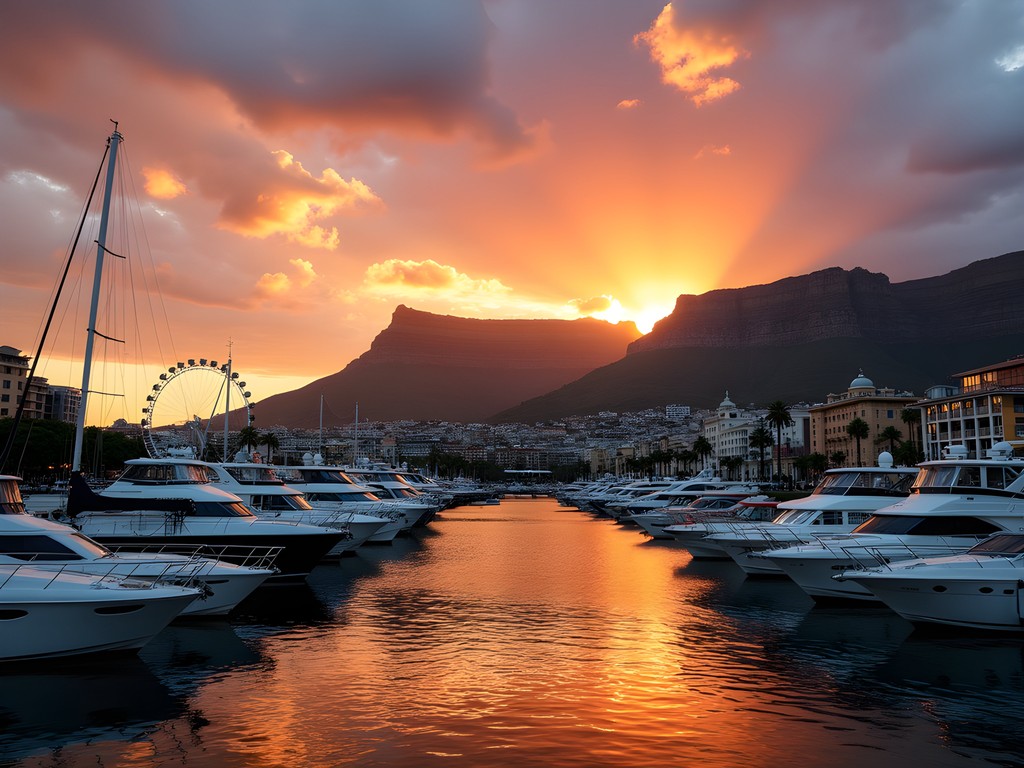
💡 Pro Tips
- Photograph the harbor at blue hour (just after sunset) when the city lights balance perfectly with the darkening sky
- Use a variable ND filter to create long exposures of boat traffic and the Cape Wheel, even during daylight hours
- Visit the Zeitz MOCAA around midday when sunlight creates the most dramatic patterns through the atrium's geometric cutouts
Chapman's Peak Drive: The Ultimate Coastal Road
Few driving routes in the world offer the photographic potential of Chapman's Peak Drive—a 9km marvel of engineering that hugs the cliffs between Noordhoek and Hout Bay. Having driven this road dozens of times during my Cape Town visits, I still discover new perspectives and lighting conditions that take my breath away.
The numerous lookout points along the drive provide perfectly positioned platforms for capturing the road's serpentine curves against the backdrop of the Atlantic Ocean. For the classic shot of the road winding along the coastline, the official Chapman's Peak viewpoint (roughly halfway along the drive) offers the ideal vantage point. Arrive an hour before sunset to set up your equipment and watch as the changing light transforms the scene minute by minute.
While the road itself makes for compelling compositions, don't overlook the details—the striated rock faces carved by centuries of wind and water, the endemic fynbos clinging to seemingly impossible cliff faces, or the patterns created by shadows as clouds move across the landscape.
For those serious about landscape photography, I recommend investing in a sturdy travel tripod that can withstand the often windy conditions along this exposed coastline. This allows for longer exposures that capture the movement of clouds and water while maintaining the sharpness of the landscape.
Timing is everything on Chapman's Peak Drive. While sunset offers dramatic backlighting and silhouettes, I've found that mid-to-late afternoon provides the most flattering light on the cliffs themselves, revealing their rich ochre and amber tones. If you're fortunate enough to visit after rain, the clarity of light creates exceptional conditions for photography, with increased visibility and vibrant colors.
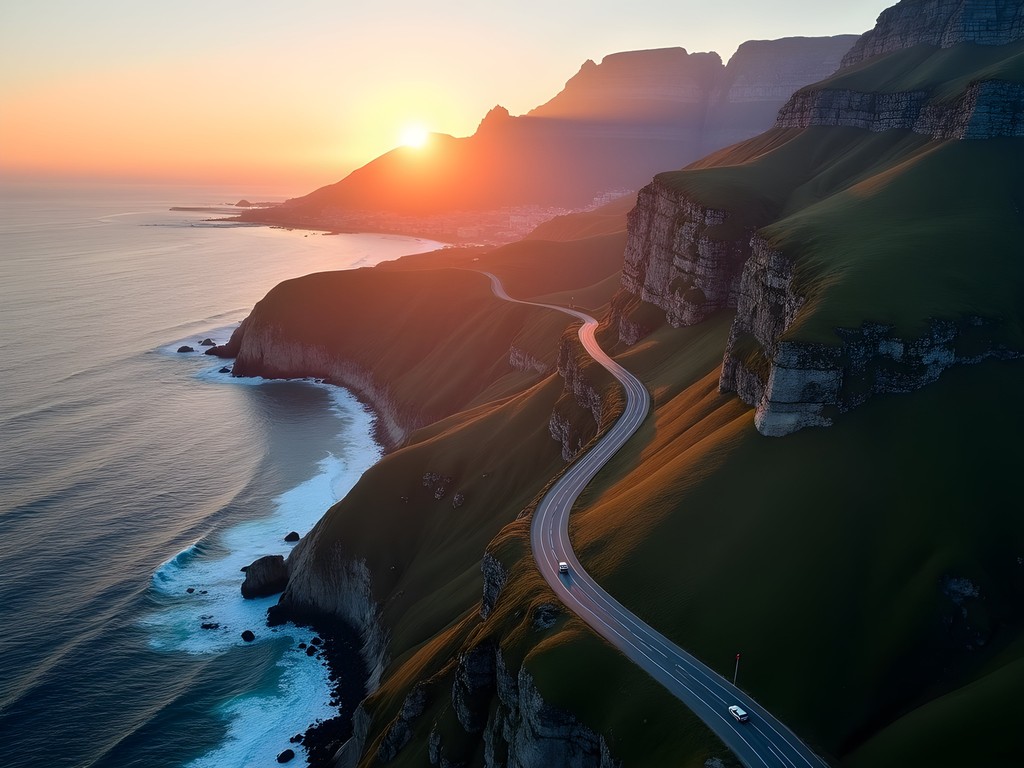
💡 Pro Tips
- Check the Chapman's Peak Drive website before visiting as the road occasionally closes due to weather conditions
- Bring graduated neutral density filters to balance the bright sky with darker foreground elements
- Look for compositions that incorporate both the engineered road and the natural landscape to tell the story of human intervention in this dramatic setting
Muizenberg Beach: Colorful Cabins & Surf Culture
The vibrant Victorian beach huts that line Muizenberg Beach have become one of Cape Town's most recognizable images—and for good reason. These candy-colored changing cabins set against white sand and blue ocean create an irresistible color palette that performs beautifully on camera and social media feeds.
While the classic shot of the beach huts in a row has been captured countless times, I've found that approaching this iconic location at different times and weather conditions yields fresh perspectives. Early morning provides the softest light and fewest people, allowing for clean compositions without crowds. The beach faces east, meaning morning light illuminates the front of the huts perfectly.
Muizenberg is also Cape Town's surfing hub, offering dynamic action shots of surfers against the colorful backdrop. Using my telephoto zoom lens, I've captured compelling images of surfers silhouetted against the golden morning light, adding a human element to the scenic landscape.
On misty mornings, which occur frequently along this stretch of False Bay, the beach huts emerge from the fog in a moody, atmospheric scene that contrasts beautifully with the typical bright, sunny images of the area. These conditions create a more contemplative, artistic interpretation of this popular location.
Don't limit yourself to ground-level shots. The elevated walkway near the beach provides higher vantage points that reveal patterns in the sand and surf not visible from eye level. For the adventurous photographer, the higher hillsides above Muizenberg offer panoramic views that place the colorful beach huts in their broader coastal context.
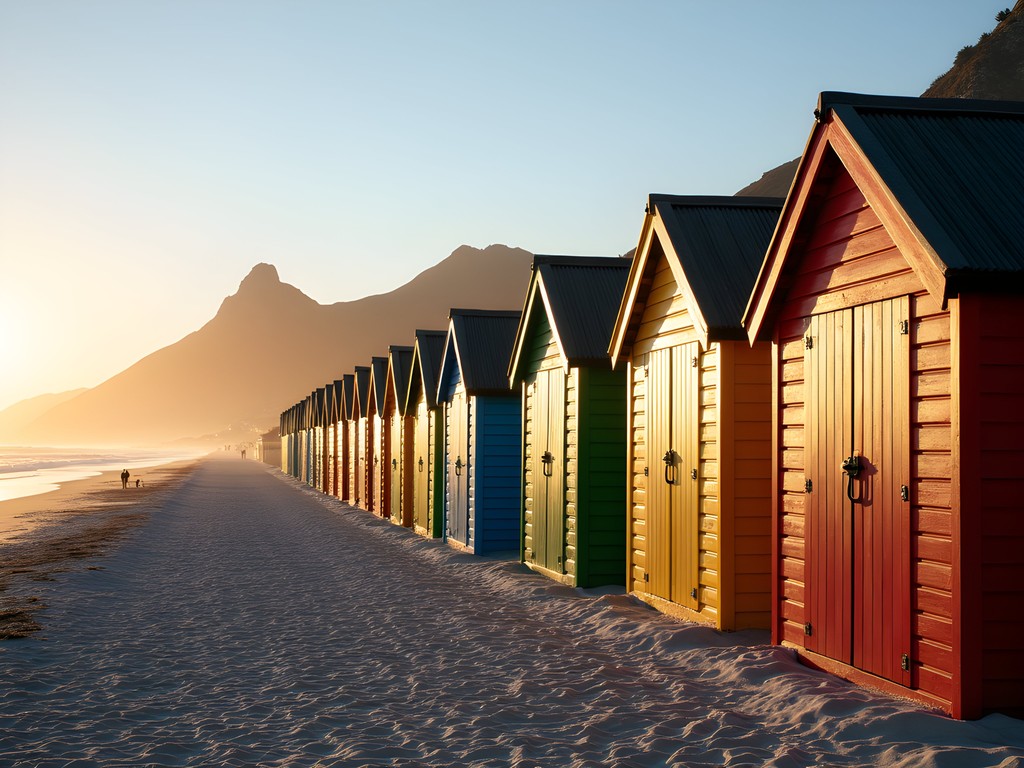
💡 Pro Tips
- Visit at low tide for reflections of the beach huts in the wet sand
- Include surfers in your compositions to add scale and a sense of place to this iconic surf spot
- Experiment with abstract close-ups of the huts' colorful doors and architectural details
Woodstock Street Art: Urban Canvas
Beyond Cape Town's postcard-perfect natural landscapes lies Woodstock—a neighborhood in creative flux where industrial buildings have become canvases for some of South Africa's most talented street artists. As someone who appreciates the intersection of urban renewal and artistic expression, I find Woodstock offers a refreshing counterpoint to Cape Town's more polished tourist destinations.
The annual International Public Art Festival has transformed this formerly overlooked area into an open-air gallery, with massive murals addressing themes from South African identity to environmental conservation. Albert Road and its surrounding streets contain the highest concentration of street art, with new pieces appearing regularly.
Photographically, these vibrant murals present interesting challenges and opportunities. The scale of many works requires wide-angle lenses to capture in their entirety, while others reward closer inspection of details and textures. I often find myself switching between my wide-angle and standard prime lenses throughout a morning of exploration here.
The industrial architecture provides context that enhances rather than distracts from the artwork—corrugated iron, weathered brick, and factory windows frame these contemporary expressions in ways that tell a story of transformation and resilience. Look for compositions that incorporate these architectural elements alongside the artwork.
Lighting can be tricky in the narrow streets, with harsh shadows during midday. I prefer photographing Woodstock's street art in the early morning when the soft light reveals colors more accurately and the streets are quieter, allowing for unhurried composition. This is also when local artists are sometimes at work on new pieces, offering opportunities for environmental portraits that capture the creative process.

💡 Pro Tips
- Download the Street Art Cities app to locate specific murals and learn about the artists
- Respect local businesses and residents while photographing—this is a working neighborhood, not just a photo backdrop
- Include environmental elements that place the artwork in context rather than isolating it completely
Boulders Beach: Penguin Paradise
There's something undeniably magical about photographing wildlife in unexpected settings, and Boulders Beach offers precisely this opportunity—a colony of endangered African penguins against the backdrop of turquoise waters and granite boulders. Located near Simon's Town on the Cape Peninsula, this protected marine area provides both conservation success story and photographic goldmine.
The wooden boardwalks that wind through the penguin colony offer excellent vantage points for observing these charismatic birds without disturbing them. While the viewing platforms can become crowded during peak hours, patience rewards the photographer with intimate moments of penguin behavior—from waddling walks to playful swimming and tender interactions between mating pairs.
Lighting considerations are crucial at Boulders Beach. The contrast between the penguins' black and white plumage presents exposure challenges, particularly in bright midday sun. I prefer visiting in the late afternoon when softer light reduces this contrast and creates a warmer ambiance that complements the coastal setting. The golden backlight can create stunning silhouettes of penguins against the ocean horizon.
While the classic shot focuses on groups of penguins on the beach, I encourage looking for more unusual compositions. Penguins swimming underwater near the shore, a solitary bird standing sentinel on a boulder, or intimate family scenes at nesting sites all tell different aspects of their story. A zoom lens with decent reach is essential—my telephoto zoom allows me to capture close-ups without encroaching on their space.
Don't overlook the landscape itself. The massive granite boulders that give the beach its name create fascinating textures and forms that can serve as foreground elements in wider environmental shots, placing the penguins in their distinctive habitat context.
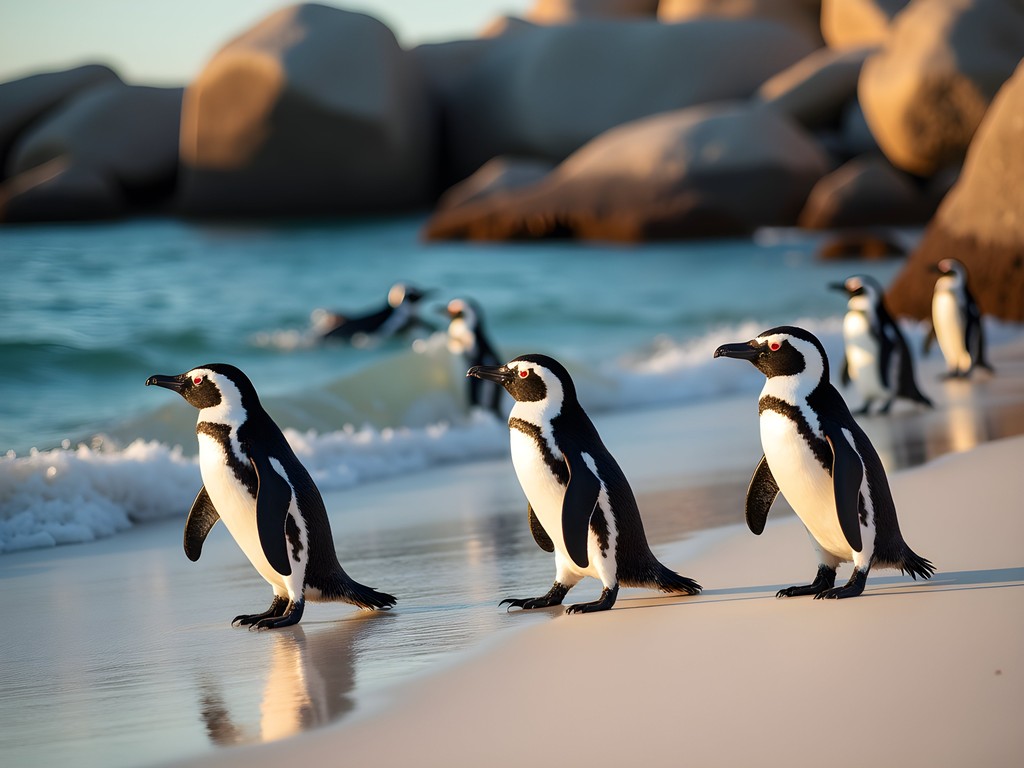
💡 Pro Tips
- Visit early morning or late afternoon to avoid both the harshest light and the largest crowds
- Use a polarizing filter to reduce glare on water and enhance the turquoise colors of the ocean
- Look for behavioral moments—penguins preening, swimming, or interacting with each other—rather than just static portraits
Signal Hill & Lion's Head: Night Photography Magic
While Cape Town's mountains offer spectacular daytime vistas, they transform into something truly magical after dark. Signal Hill and Lion's Head provide accessible vantage points for night photography that captures the city's illuminated geography—the perfect way to contextualize Cape Town's unique position between mountain and sea.
Signal Hill offers the easiest access for night photography, with vehicle access to viewpoints that showcase the city bowl, harbor, and Atlantic Seaboard. Arriving about 30 minutes before sunset allows you to set up equipment and capture the transition from golden hour through blue hour and into full darkness. This transition period—when the sky retains deep blue tones while city lights begin to glow—creates a perfect exposure balance that's difficult to achieve in complete darkness.
For more adventurous photographers, Lion's Head can be climbed for sunset and early evening photography, though I strongly advise descending before complete darkness unless you're with an experienced guide. The 360-degree views from the summit allow compositions that incorporate both the city lights and the distant glow of camps Bay and Clifton beaches.
Technical considerations become paramount in these conditions. A solid tripod is non-negotiable for the longer exposures required after sunset. I always carry extra batteries as night photography drains them quickly, especially in cooler conditions. My remote shutter release prevents camera shake during long exposures, ensuring tack-sharp city light images.
Experiment with different exposure times to capture car light trails along the coastal roads—these create leading lines that draw the viewer's eye through your composition. The movement of ships in the harbor and aircraft approaching the airport add additional light elements that can enhance night compositions when captured with exposures of 10-30 seconds.
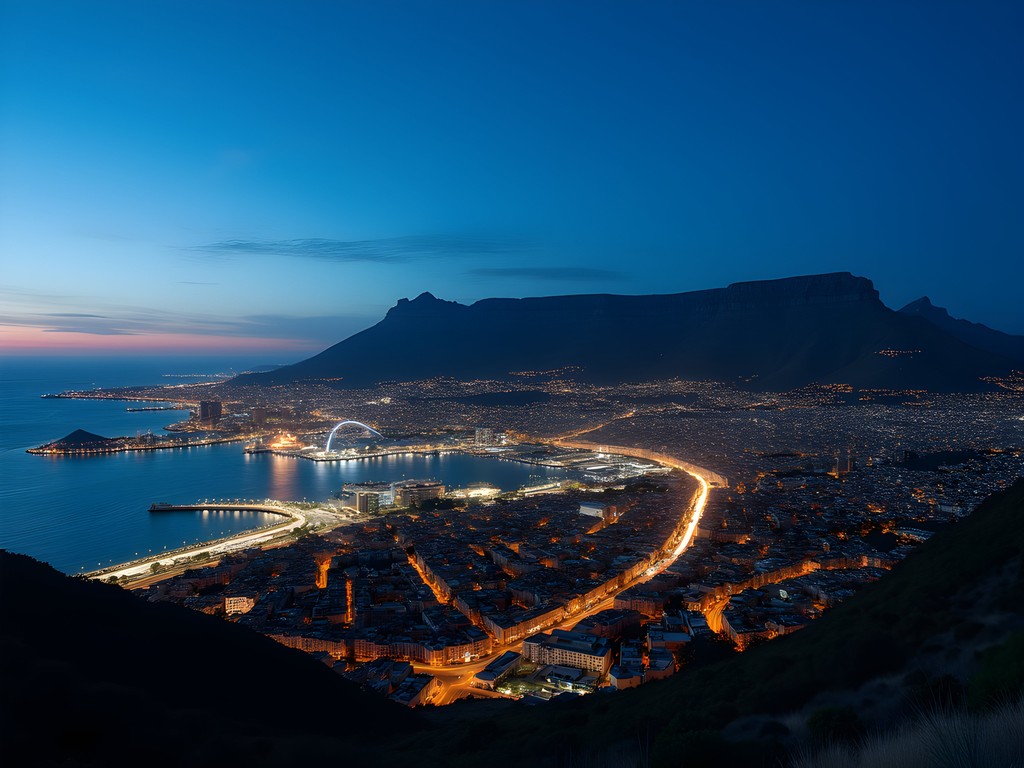
💡 Pro Tips
- Use the 500 rule to determine maximum exposure time before stars begin to streak (500 ÷ focal length)
- Set your white balance manually rather than using auto—typically 3200-4000K works well for city lights
- Bring a headlamp with a red light option to preserve your night vision while adjusting camera settings
Camps Bay & Clifton Beaches: Coastal Glamour
The Atlantic Seaboard beaches of Camps Bay and Clifton represent Cape Town's most glamorous coastal stretches—where pristine white sand meets turquoise water against the dramatic backdrop of the Twelve Apostles mountain range. These locations offer the perfect blend of natural beauty and sophisticated beach culture that performs beautifully through the lens.
Camps Bay's wide expanse allows for expansive compositions that capture the relationship between mountain and sea. The palm-lined promenade creates leading lines that draw the viewer's eye toward the distinctive peaks of the Twelve Apostles. Sunset here is particularly magical, as the beach faces west, providing front-row seats to the sun sinking into the Atlantic Ocean.
Clifton's four distinct beaches, separated by granite boulders, offer more intimate compositions. The massive rocks create natural frames and foreground elements that add depth to your images. Clifton 4th Beach, with its pristine white sand and azure water, creates a color palette that epitomizes coastal perfection—particularly when photographed from elevated positions along the coastal road.
Both locations transform throughout the day. Morning brings soft, diffused light that's ideal for capturing the texture of the sand and the clarity of the water. Midday creates challenging harsh light but can work well for minimalist compositions that emphasize the contrast between deep blue sky and white sand. Late afternoon introduces warm golden tones that complement the natural colors of the landscape.
For something beyond the standard beach scene, look for the interactions between people and place—surfers carrying boards along Camps Bay at sunset, the colorful umbrellas dotting Clifton's beaches like confetti, or the silhouettes of paragliders drifting down from Lion's Head against the coastal backdrop. These human elements add scale and storytelling dimensions to your coastal portfolio.
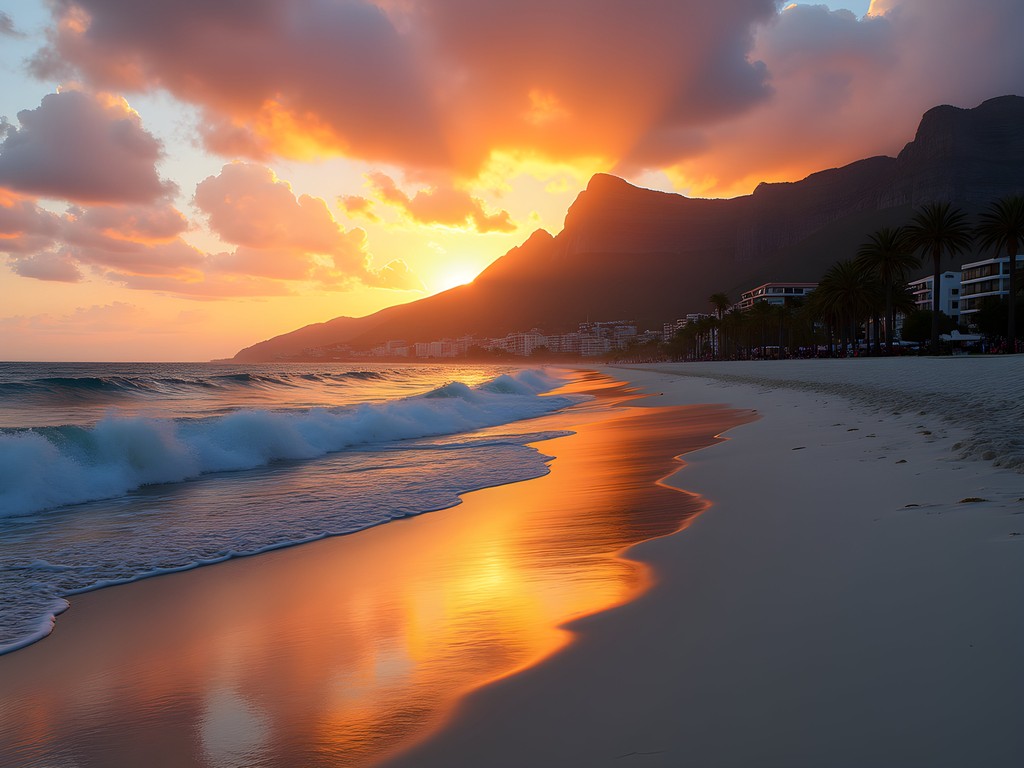
💡 Pro Tips
- Visit Camps Bay at sunset for classic golden light on the Twelve Apostles mountains
- Photograph Clifton beaches from the elevated roadside viewpoints for context that shows all four beaches
- Use a polarizing filter to cut glare on water and enhance the blues and turquoise tones
District Six Museum & Robben Island: Capturing History
Photography isn't just about capturing beautiful landscapes—it's also about documenting places of historical significance that tell important stories. Cape Town offers two profound locations for this type of photography: the District Six Museum and Robben Island. Both sites represent critical chapters in South Africa's apartheid history and its journey toward democracy.
The District Six Museum commemorates a once-vibrant, multicultural neighborhood that was systematically destroyed under apartheid, with over 60,000 residents forcibly removed. Photographically, the museum presents unique indoor challenges and opportunities. The intimate space is filled with evocative artifacts, maps, and personal testimonies that require thoughtful composition to capture meaningfully.
Rather than attempting to document everything, I focus on finding details that tell the broader story—handwritten letters, the massive floor map showing the original street layout, or the vintage signs from shops that once lined the district's streets. These intimate details often convey the human impact more powerfully than wider shots.
Robben Island, where Nelson Mandela spent 18 of his 27 imprisoned years, requires a different approach. The stark prison buildings, set against the backdrop of Table Mountain across the water, create powerful visual contrasts. The limited tour time means preparation is essential—know which locations you want to prioritize photographically before arriving.
Mandela's cell, with its simple bed and bucket, presents a compositional challenge due to its small size and the groups moving through. I've found that focusing on the light falling through the small window onto the sparse furnishings creates an image that speaks to both confinement and the enduring hope that defined Mandela's imprisonment.
Both locations require a respectful approach to photography. At the District Six Museum, always ask permission before photographing people or their personal artifacts. On Robben Island, follow guide instructions about where photography is permitted and be mindful not to disrupt other visitors' experience with your photography.
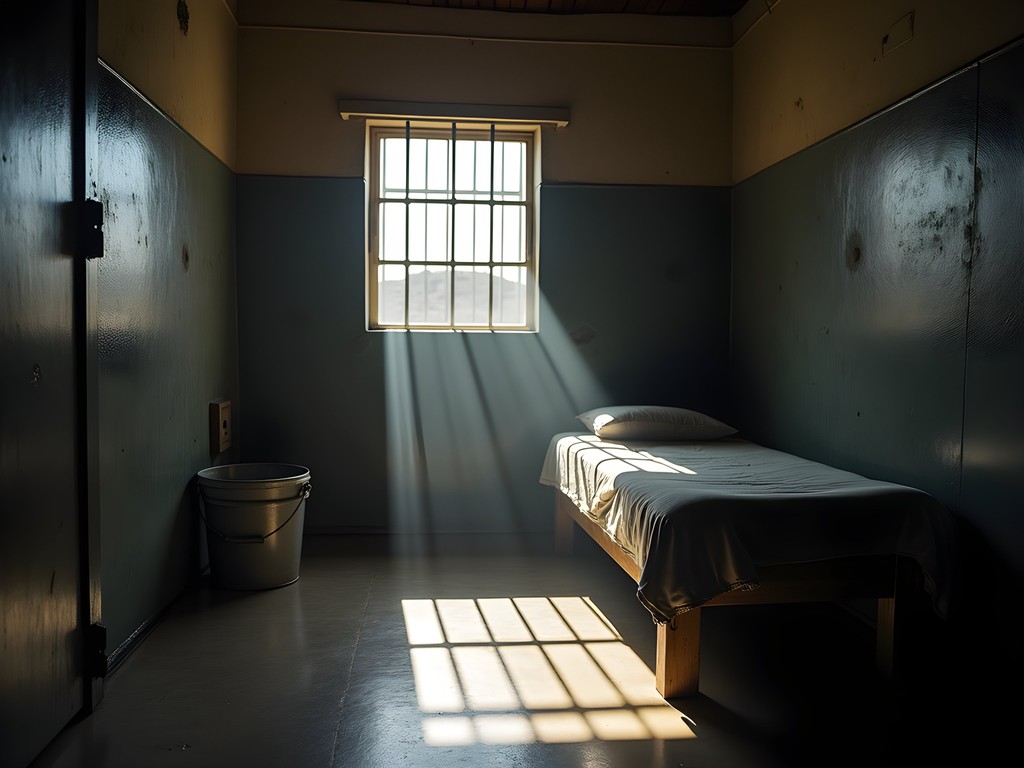
💡 Pro Tips
- Use available light rather than flash in the District Six Museum to preserve the atmospheric quality
- At Robben Island, incorporate Table Mountain in background compositions to create context for the isolation of the prison
- Consider black and white processing for some images to connect visually with the historical period being commemorated
Final Thoughts
Cape Town's photographic treasures extend far beyond these 12 locations—each visit reveals new perspectives and possibilities in this city of contrasts. What makes Cape Town truly special for photographers is this remarkable diversity of subject matter within such a compact geographic area. In a single day, you can capture dramatic landscapes, vibrant street life, poignant historical sites, and extraordinary wildlife—all bathed in that distinctive Cape light that seems to amplify every color and texture. As you plan your own photographic journey through the Mother City, remember that the most compelling images often emerge when you allow yourself to slow down, engage with your surroundings, and look beyond the obvious postcard shots. The story of Cape Town isn't just in its iconic landmarks but in the connections between them—the threads of history, culture, and natural beauty that weave this extraordinary destination together. I'd love to see what you capture on your own Cape Town adventure—tag me in your Instagram posts so we can continue this visual conversation about one of my favorite cities on earth.
✨ Key Takeaways
- Visit key locations during golden hour (one hour after sunrise or before sunset) for optimal lighting conditions
- Balance iconic landmarks with authentic cultural experiences that tell deeper stories about Cape Town
- Use a variety of focal lengths to capture both sweeping landscapes and intimate details
- Engage respectfully with locals to create more meaningful photographic narratives
📋 Practical Information
Best Time to Visit
September to November (spring) offers mild temperatures, fewer crowds, and spectacular wildflowers
Budget Estimate
$100-200 per day including mid-range accommodation, transportation, and meals
Recommended Duration
7-10 days to cover all locations without rushing
Difficulty Level
Intermediate - Some Locations Require Moderate Hiking Or Early Morning Starts
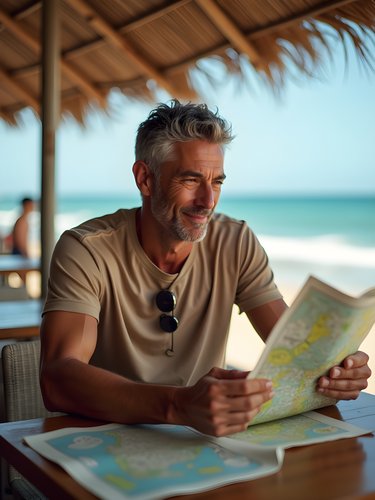
















Comments
smartblogger
Did you feel safe carrying camera gear around Cape Town? Any neighborhoods to avoid?
cityfan
Not Brandon but I was there in March. I felt fine in tourist areas during the day but used Uber after dark and kept gear in a non-camera bag. Basic city awareness is enough.
Brandon Tanaka
Exactly what cityfan said - be street smart like in any major city. I never had issues but I don't flash expensive gear unnecessarily. The V&A Waterfront and main tourist areas are well patrolled.
bluephotographer
Your Table Mountain shots are giving me serious wanderlust! What time of day did you shoot the one with that golden light? I'm planning my first trip to Cape Town and want to make sure I don't miss those perfect lighting conditions. I've got my travel tripod ready to go!
Brandon Tanaka
That golden light shot was about 30 minutes before sunset from Lions Head. Get there at least an hour before sunset to find your composition - it gets crowded! And yes, definitely bring a tripod for those twilight shots.
Douglas Bradley
Brilliant curation of spots, Brandon! I spent three weeks photographing Cape Town last year and would add Signal Hill at sunset for that perfect golden hour cityscape. The juxtaposition of urban architecture against natural formations creates compelling visual narratives. I found that visiting Kirstenbosch on weekdays around opening time lets you capture the gardens without crowds. The elevated walkway through the canopy offers perspectives most visitors miss. Your Bo-Kaap section perfectly captures the cultural significance beyond just the colorful facades that dominate Instagram.
wildstar
Is Cape Point really worth the trip? Wondering if I should include it in my 4-day itinerary next month.
Douglas Bradley
Absolutely worth it! I'd recommend allocating a full day for Cape Point and the scenic drive there. The dramatic cliffs where the oceans meet create stunning compositions, especially if you can catch it during golden hour.
wildstar
Thanks for the tip! Will definitely add it to my itinerary then.
cityfan
Those Bo-Kaap shots are incredible! The colors just pop in your photos.
Brandon Tanaka
Thanks! The colors there are so vibrant they almost don't look real, but I promise there's no heavy editing!
Bryce Diaz
Brandon, your post brought back so many memories! I still remember standing at that exact spot in Bo-Kaap, chatting with a local woman who'd lived in her bright yellow house for 40+ years. She told me the colors were originally an expression of freedom after apartheid ended. Each home has a story behind its vibrant paint job. My favorite photo from Cape Town wasn't even planned - I was hiking Lion's Head at dawn, completely exhausted, when the fog suddenly cleared and revealed the city below bathed in pink light. Sometimes the best shots are the unplanned ones, right? For anyone going, don't rush these spots - each deserves time to explore beyond the obvious frame.
roamrider878
That Bo-Kaap story is amazing! I had no idea about the colors representing freedom. Makes me appreciate the photos even more.
smartmood
Did you find it easy to get around to all these spots? Rent a car or use public transport?
Brandon Tanaka
I rented a car for the Cape Point/Cape of Good Hope day, but used Uber for city spots like Bo-Kaap and Signal Hill. It was surprisingly affordable and I didn't have to worry about parking!
luckyrider
Just booked my tickets to Cape Town for January after seeing this post! Can't wait to check out all these spots!
Sarah Powell
You're going to love it! January has perfect weather too.
Douglas Bradley
Excellent compilation, Brandon. I'd add that seasonal considerations significantly impact these photo spots. I visited Cape Town in both winter (June) and summer (December), and the experiences were dramatically different. The winter light created moody, atmospheric conditions at Cape Point, while summer provided those vibrant blue skies for Bo-Kaap. The proteas at Kirstenbosch bloom best from late winter to spring. For those serious about photography, I'd recommend planning around these seasonal variations based on your preferred aesthetic. My travel tripod was essential for low-light situations at Signal Hill during blue hour.
sunnyvibes
What's the best time of day to visit Kirstenbosch Gardens for photos? Morning or afternoon light?
Brandon Tanaka
Late afternoon is magical at Kirstenbosch! The light filters through the trees and creates these beautiful dappled patterns. If you can time it 2-3 hours before sunset, you'll get the mountain backdrop with perfect lighting.
Venture X
Premium card with 2X miles, $300 travel credit, Priority Pass